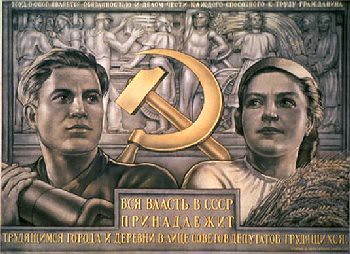I warmly point out that one Marxist recently objected to Bertholt Brecht's statement that "art is a hammer with which to shape reality." This Marxist called Brecht's comment "almost obscene" and said "oh when will we learn to appreciate and engage something so gentle and so moving and so profound as our creative selves." It is interesting to note that "revisionists attack the Marxist-Leninist principle of partisanship in art." And they have in the past "opposed the guidance of art by the Communist Party." (Afanasyev, Marxist Philosophy, Foreign Languages Publishing House, Moscow)
What is the Marxist-Leninist view of the "diverse kinds of art: poetry and fiction, theatre, music, the cinema, architecture, painting sculpture"? "In a class society art bears a class character, it is partisan. There is no ’pure art, ’ no ’art for art’s sake, ’ nor can there be any. The accessibility, the great power of conviction and emotional influence of art make it an important weapon of the class struggle. That is why classes exploit art as a vehicle of their political, moral and other ideas...
"Contemporary bourgeois art, for example, serves the reactionary imperialist forces. It seeks to divert the working people from struggle against the exploiters...Bourgeois art is employed to glorify the capitalist order of things..." (Afanasyev, Marxist Philosophy, Foreign Languages Publishing House, Moscow)
Whereas "a qualitatively new, socialist art has arisen on the basis of the revolutionary struggle of the working class and its advance to communism. Socialist art assimilates the best from progressive art of the past and constitutes a higher stage in the development of art corresponding to the new conditions. Socialist realism is the creative method of this art." Socialist realism's basic principles are "kinship with the people (and) partisanship and bold pioneering in the artistic portrayal of life." And "the organic ties of socialist art with the people, their life and work are unprecendented...Socialist realism is conspicous by its profound socialist content." (Afanasyev, Marxist Philosophy, Foreign Languages Publishing House, Moscow)

’Art (is)...an an important weapon of the class struggle.’
Gus Hall, the former leader of the Communist Party USA, would agree with the statement that "each class creates an art that corresponds to its class interests and aesthetic requirements." (Afanasyev, Marxist Philosophy, Foreign Languages Publishing House, Moscow)
"Culture," Gus Hall wrote in Power of Ideology, "is used by the ruling class as a potent weapon." And "culture, both bourgeois and working class, influences people on an unconscious level. It influences from the inside of developments. No one says 'this is bourgeois culture' or 'this is working class culture.' There are no tags on the outside. Nevertheless, there is a very clear, distinct difference between the two." (Gus Hall, Power of Ideology, 1989, New Outlook Publishers)
Hall continues: "Some have indicated that we should not try to use our ideology to influence cultural developments. But this is an integral part of the ideological struggle--to influence thought patterns...
"The ideological struggle in the field of culture is very sharp. It takes place on the stage, the screen, in music, art and poetry. It pervades fiction and non-fiction, especially history.
"Culture is also influenced by aesthetics, concepts of beauty, color and form. But the more basic influence is the struggle between the two ideologies (capitalist and working class). Yes, we take sides in this struggle, as we do in other areas." (Gus Hall, Power of Ideology, 1989, New Outlook Publishers)



